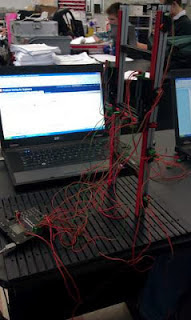Thursday, February 27, 2014
Soccer Goal
This soccer goal will turn on the red lamp on top of the goal if a goal is scored. The photoresistors inside the goal will sense when the ball passes by the lights and turn on the lamp on top signifying a goal.
Wednesday, February 5, 2014
3.1.6 Open and Closed Loops
1. We built the support system and track.
2. We added the motor and gearbox.
4. N/A
5. This is an open loop because there is nothing to provide feedback to the system.
6. The gearbox would come to rest far to the right than it started.
7. The process does have an inefficiency because it travels more one way than the other everytime the process is repeated. Also, if something slows the motor down one way, the motor will not adjust to keep the constant speed.
8. Here is the flowchart.
9. This is a closed loop because it responds to feedback.
10. This would be very precise because it would never get passed the mini-switches so it will alway have the same range of motion.
CONCLUSION:
1. A cell phone is an open loop system. The program starts when it recieves an incoming call and it ends when the "END" button is pressed. The system could benefit from feedback because hitting the end button ends the process and the end button is a feedback.
2. An air conditioner is a closed loop system. The feedback it gets comes from a thermometer. If the temperature is higher than the set temperature, it will cool the house down until the set temperature is reached. If the temperature is lower than the set temperature, it will warm the house up until the set temperature is reached
Monday, February 3, 2014
3.1.5 Variable Function

14. The light was on for 5 seconds.
15.
Conclusion:
16. You can have a Plus 1 command and then the next step could have a Minus 1 command. That will make the variable block equal zero.
17. An industrial or manufacturing engineering may need to keep track of how many products they place in a box. If the box can only hold 10 items, then the engineer will have to set the program so that it stops after it places 10 items in the box so that they can switch out the box.
Monday, January 27, 2014
3.1.4 Branch Functions
3. The lamp will continuously be lit if I1 is wired normally open and the switch is never pushed.
4. Right click and manipulate properties
5. run program
7./8./9./10./11.
Input 1 (I1) is a potentiometer with an analog range from 42-5000
For these 5 questions, this flowchart was only manipulated slightly.
CONCLUSION:
1. It is important to include branches because the program can make decisions based on actions that you perform.
2. A normally open switch is a light switch. It is open when it is off and closed when it
3. A normally closed switch is a store alarm. It is constantly on until someone types in the password and turns it off.
Wednesday, January 22, 2014
3.1.3 Basic Programing

Conclusion:
1. The best way to make sure that all of your devices are in the correct ports of the interface and have been wired correctly is to hit the test button at the top of the ROBOPro screen.
2. The importance of labelingn block functions within a flowchart makes it easier for you to understand which motors are going and stopping.
Subscribe to:
Posts (Atom)



















